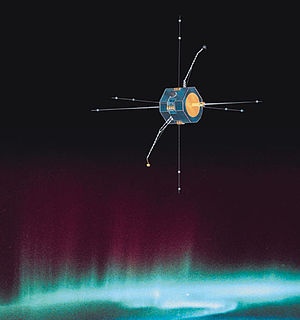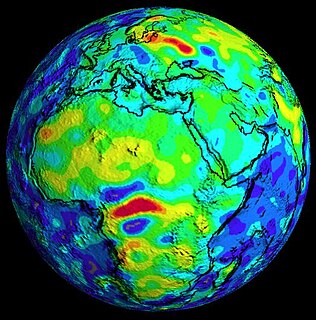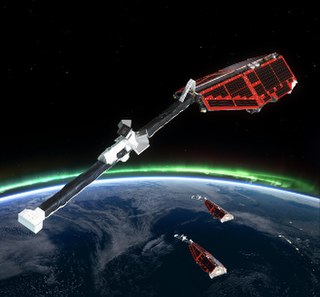
Ulysses is a decommissioned robotic space probe whose primary mission was to orbit the Sun and study it at all latitudes. It was launched in 1990 and made three "fast latitude scans" of the Sun in 1994/1995, 2000/2001, and 2007/2008. In addition, the probe studied several comets. Ulysses was a joint venture of NASA and the European Space Agency (ESA) under leadership of ESA with participation from Canada's National Research Council. The last day for mission operations on Ulysses was June 30, 2009.

Pioneer 6, 7, 8, and 9 were space probes in the Pioneer program, launched between 1965 and 1969. They were a series of solar-orbiting, spin-stabilized, solar cell- and battery-powered satellites designed to obtain measurements on a continuing basis of interplanetary phenomena from widely separated points in space. They were also known as Pioneer A, B, C, and D. The fifth was lost in a launch accident, and therefore did not receive a numerical designation.

Explorer 35 was a spin-stabilized spacecraft built by NASA. Designed for the study of the interplanetary plasma, magnetic field, energetic particles, and solar X rays. Launched into an elliptical lunar orbit, the spacecraft was shut down on June 24, 1973 after all its mission objectives were achieved after 6 years.

Ørsted is Denmark's first satellite, named after Hans Christian Ørsted (1777–1851), a Danish physicist and professor at the University of Copenhagen, who discovered electromagnetism in 1820.

Explorer 52, also known as Hawkeye 1, Injun F, and the Neutral Point Explorer, was an American satellite launched on June 3, 1974, from Vandenberg Air Force Base on a Scout booster.

The Time History of Events and Macroscale Interactions during Substorms (THEMIS) mission began in February 2007 as a constellation of five NASA satellites to study energy releases from Earth's magnetosphere known as substorms, magnetic phenomena that intensify auroras near Earth's poles. The name of the mission is an acronym alluding to the Titan Themis.

The Fast Auroral Snapshot Explorer (FAST) was a NASA plasma physics satellite, and was the second spacecraft in the Small Explorer program. It was launched on August 21, 1996, from Vandenberg Air Force Base aboard a Pegasus XL rocket. The spacecraft was designed and built by NASA's Goddard Space Flight Center. Flight operations were handled by Goddard for the first three years, and thereafter were transferred to the University of California, Berkeley's Space Sciences Laboratory.
Dynamics Explorer was a NASA mission, launched on August 3, 1981 and terminated on February 28, 1991. It consisted of two unmanned satellites, DE-1 and DE-2, whose purpose was to investigate the interactions between plasmas in the magnetosphere and those in the ionosphere. The two satellites were launched together into polar coplanar orbits, which allowed them to simultaneously observe the upper and lower parts of the atmosphere.

In geophysics, a magnetic anomaly is a local variation in the Earth's magnetic field resulting from variations in the chemistry or magnetism of the rocks. Mapping of variation over an area is valuable in detecting structures obscured by overlying material. The magnetic variation in successive bands of ocean floor parallel with mid-ocean ridges was important evidence for seafloor spreading, a concept central to the theory of plate tectonics.

The Magnetospheric Multiscale (MMS) Mission is a NASA robotic space mission to study the Earth's magnetosphere, using four identical spacecraft flying in a tetrahedral formation. The spacecraft were launched on 13 March 2015 at 02:44 UTC. The mission is designed to gather information about the microphysics of magnetic reconnection, energetic particle acceleration, and turbulence—processes that occur in many astrophysical plasmas. As of March 2020, the MMS spacecraft have enough fuel to remain operational until 2040.

Spacecraft magnetometers are magnetometers used aboard spacecraft and satellites, mostly for scientific investigations, plus attitude sensing. Magnetometers are among the most widely used scientific instruments in exploratory and observation satellites. These instruments were instrumental in mapping the Van Allen radiation belts around Earth after its discovery by Explorer 1, and have detailed the magnetic fields of the Earth, Moon, Sun, Mars, Venus and other planets and moons. There are ongoing missions using magnetometers, including attempts to define the shape and activity of Saturn's core.

Swarm is a European Space Agency (ESA) mission to study the Earth's magnetic field. High-precision and high-resolution measurements of the strength, direction and variations of the Earth's magnetic field, complemented by precise navigation, accelerometer and electric field measurements, will provide data for modelling the geomagnetic field and its interaction with other physical aspects of the Earth system. The results offer a view of the inside of the Earth from space, enabling the composition and processes of the interior to be studied in detail and increase our knowledge of atmospheric processes and ocean circulation patterns that affect climate and weather.
Kosmos 49, also known as DS-MG No.2 was a scientific satellite which was launched by the Soviet Union in 1964. This mission used proton magnetometers to map the Earth's magnetic field and, along with Kosmos 26, represented the USSR's contribution to the International Quiet Solar Year World Magnetic Survey. The corresponding American measurements were performed by the satellites OGO 2 and OGO 4. It also conducted scientific research into the Earth's infrared flux and ultraviolet flux.

Explorer 10 was an American Earth-orbital satellite that investigated Earth's magnetic fields and nearby plasma. Launched on March 25, 1961, it was an early mission in the Explorer program and was the first satellite to measure the "shock wave" generated by a solar flare.

Magnetometer (MAG) is the name of an instrument suite on the Juno orbiter for planet Jupiter. The MAG instrument includes both the Fluxgate Magnetometer (FGM) and Advanced Stellar Compass (ASC) instruments. There two sets of MAG instrument suites, and they are both positioned on the far end of three solar panel array booms. Each MAG instrument suite observes the same swath of Jupiter, and by having two sets of instruments, determining what signal is from the planet and what is from spacecraft is supported. Avoiding signals from the spacecraft is another reason MAG is placed at the end of the solar panel boom, about 10 m and 12 m away from the central body of the Juno spacecraft.

Explorer 45 was a NASA satellite launched as part of Explorers program. Explorer 45 as launched on 15 November 1971 from the San Marco platform of the Broglio Space Center, with a Scout rocket. Explorer 45 was the only one to be released from the program Small Scientific Satellite.

Charge Composition Explorer, also called as CCE, AMPT/CCE, Explorer 65 or AMPTE 1, was a NASA satellite designed and tasked to study Earth's magnetosphere, being launched as part of the Explorers program. CCE was launched with the two other satellites of the AMPTE mission on August 16, 1984 from a Cape Canaveral launch pad by a Delta 3924 rocket. It was placed in an equatorial orbit of 1,100 kilometres (680 mi) × 50,000 kilometres (31,000 mi) with an inclination of 4.8 degrees. CCE is one of the components of the international space mission AMPTE, which also includes MRI, designed by West Germany, and UKS, provided by the United Kingdom.

FIELDS is a science instrument on the Parker Solar Probe (PSP), designed to measure magnetic fields in the solar corona during its mission to study the Sun. It is one of four major investigations on board PSP, along with WISPR, ISOIS, and SWEAP. It features three magnetometers. FIELDS is planned to help answer an enduring questions about the Sun, such as why the solar corona is so hot compared to the surface of the Sun and why the solar wind is so fast.
Tandem Reconnection and Cusp Electrodynamics Reconnaissance Satellites (TRACERS) is a planned orbiter mission tasked to study the origins of the solar wind and how it affects Earth. The Principal Investigator is Craig Kletzing at the University of Iowa in Iowa City, Iowa. Not including rideshare costs, TRACERS is funded US$115 million.

Galileo was an American robotic space probe that studied the planet Jupiter and its moons, as well as several other Solar System bodies. Named after the Italian astronomer Galileo Galilei, it consisted of an orbiter and an entry probe. It was delivered into Earth orbit on October 18, 1989 by Space ShuttleAtlantis. Galileo arrived at Jupiter on December 7, 1995, after gravitational assist flybys of Venus and Earth, and became the first spacecraft to orbit Jupiter.




















